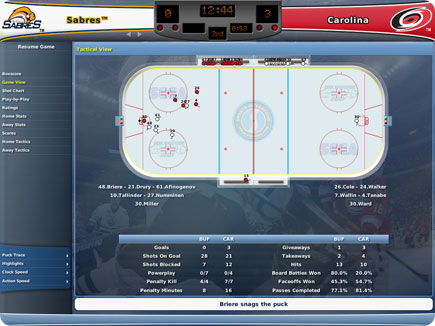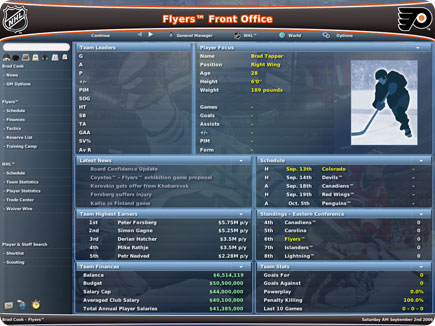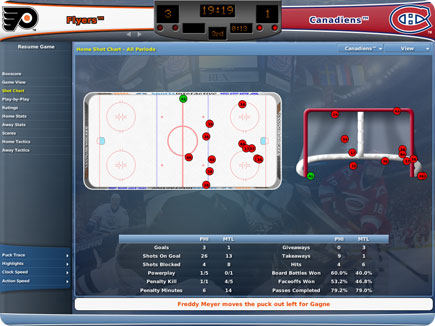By Brad Cook
3-2. Just over a minute remaining in the third period. The other team commits a crucial mistake by icing the puck, placing the next face-off in their end. You respond by sending out your best line, with orders for your goalie to leave the ice for an extra attacker if your team wins the face-off. Leaving the net empty is always a risky proposition, but you need any advantage you can get at the moment: a win secures the number one seed in the playoffs.

The referee drops the puck and your center skillfully draws it back to one of your defensemen, who immediately wraps it around the boards to the left and right wingers stationed by the net. You’ve ordered your players to press hard and barrage the opposing goalie with shots, which they do as your own goalie skates off. You even took a moment to assess a chart of shot placement and decided to tell them to aim low — clearly all those high shots weren’t getting through.
Your tactics pay off with a score just 38 seconds later as your star left winger puts the puck just inside the right post. You restore your goalie but keep your best players on the ice despite their exhausted state — nobody wants to slog through overtime if they can put the game away now. Time runs out, however, and you plan your overtime strategy, deciding to keep everything the same except the players’ shooting tactics: better to have them control the puck more and set up their shots.
With just five minutes on the clock, though, overtime ends in a 3-3 tie, ending your hopes for a division title and dropping your team to fourth seed in the playoffs. You mull over your roster before the first round begins, noting that your star left winger is still unhappy, despite a lucrative contract extension offered to him earlier in the season. And with your best defenseman hurt, you’ll have to plug into your line-up a rookie summoned from your minor league affiliate a few months prior. At least the team’s board of directors is still happy with your performance. For now.
Hockey Immersion
Welcome to the world of professional hockey as portrayed in Sports Interactive’s NHL Eastside Hockey Manager 2007. This hockey management game features 20 playable leagues — including, of course, North America’s National Hockey League — from around the world, with more than 3,000 teams and over 45,000 players and personnel contained in its enormous database. You can take charge of any of those teams and lead it to victory as you make trades, sign up-and-coming players, decide game-day tactics as you watch the play-by-play unfold, negotiate new contracts with veterans, bench underachievers, and more.
Best of all, thanks to Eastside Hockey Manager’s plethora of licensing deals, you get to interact with real players and personnel while managing your favorite team. Oversee the rise of young phenom Sidney Crosby, who was drafted by the Pittsburgh Penguins as the successor of Mario Lemieux. Decide whether aging veteran Dominic Hasek still has what it takes to play goalie for the Detroit Red Wings or if you should go with the younger Chris Osgood. Take the reins of recent expansion team the Columbus Blue Jackets and see if you can turn them into an NHL powerhouse. The choice is yours, the possibilities limited only by the schemes you can create.
Your NHL season starts before the exhibition games do, giving you an opportunity to peruse your roster and make sure your key players are signed to contracts and happy with their situations. The game follows NHL rules to the letter, which means you have to take roster freeze dates and trade deadlines into account as you juggle your line-up. With a limit of 23 players on the team and 20 who can be available for each game, it’s up to you to place injury victims on the reserve list, which doesn’t count against the 23-player maximum, and summon replacements from your minor league affiliate.
Daily news blurbs keep you abreast of everyone’s status and even let you know what’s happening with other teams around the league. Someone else’s star player could be unhappy, so you better swoop in with a sweet trade offer before another team beats you to him.
And like any other general manager does, you get to spend your off-season time securing key contracts, evaluating players you made offers to earlier in the year who are now available, and otherwise getting ready for the next campaign. As your reputation within this simulated digital world grows, you’ll eventually find a consensus opinion of your job performance. If you’re good enough, you might just join the ranks of the few general managers in the hockey Hall of Fame.
Game Hardware
Check out our systems for your best gaming experience.
- Site: NHL Eastside Hockey Manager 2007
- Publisher: Sports Interactive
- Developer: Sports Interactive
- Genre: Sports
Game Media

He Shoots! He… Follow all of the action in the tactical view.

Just Another Day at the Office. Trade, waive, and sign players, manage finances, check your team’s stats, and more.

Take a Shot At It. Check out shot placement, as well as where players were when they took them, and adjust your strategy accordingly.
If you liked this game, check out:
System Requirements:
- Mac OS X version 10.3 (10.4 recommended)
- 600MHz PowerPC G4 processor (1.4GHz or higher recommended)
- 256MB of RAM
- 800MB hard disk space
A Tour of the NHL
While there are 20 leagues in the game, we realize most of you are interested in the NHL. If you don’t have a favorite team, however, take a look at the following guide and see what sparks your interest. From established clubs laden with stars to struggling expansion franchises to teams with up-and-down histories, the NHL offers something for the type of challenge you have in mind. The following descriptions are based on the team rosters included with the game, which were set before the start of the current season. Therefore, our comments may not reflect current events, such as players who have been recently traded or waived. Your simulated season may turn out much differently than the real one, which, of course, is the point of playing games like this one.
